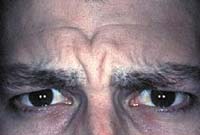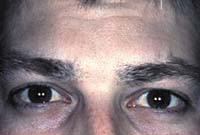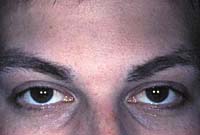Botulinum toxin/Botox use continues to increase for cosmetic surgery
Clinical trials of Botox demonstrated great promise in substantially reducing glabellar lines.
Click Here to Manage Email Alerts
 |
 |
COURTESY OF ALASTAIR CARRUTHERS, MD
SAN FRANCISCO — Clinical trials of botulinum toxin type A (Botox; Allergan) demonstrated great promise in substantially reducing glabellar lines for the majority of study patients. Treatment benefits spiked 1 month after injection and were maintained for up to 4 months, and there were no statistically significant differences between the Botox treated group and the placebo treated group in any adverse events, according to one study.
“This is the start of the good scientific evidence that is needed to justify this type of treatment,” Alastair Carruthers, MD, a clinical professor of dermatology at the University of British Columbia, told Ocular Surgery News.
“What has happened since that first person had been treated with Botox is good scientific evidence, good data demonstrating the appropriate dose, injection technique, safety and longevity.” Dr. Carruthers presented phase 3 clinical trials here at the American Academy of Dermatology meeting.
Botox addiction
 |
 |
COURTESY OF ALASTAIR CARRUTHERS, MD
The phase 3 double-blind study compared a 20-unit dose of Botox to placebo for the treatment of patients with glabellar lines.
A total of 263 patients with moderate to severe glabellar lines at maximum frown were enrolled in this study. Patients were injected with either a 20-unit dose of Botox or placebo.
According to investigators’ evaluation of the study’s patients, at day 30 after the injection, 83.7%, or 170 patients of the Botox treated group, had glabellar line severity rated none or mild at maximum frown, compared with 0% of the placebo group. According to patient self-assessment at the same time period, 90.1%, or 183 patients of the Botox group, rated their appearance at least moderately improved, compared with 0% of the placebo group.
These results are statistically significant, researchers said, and so were the results at every time point, starting with the seventh day after the injection and monthly thereafter until the end of the study at day 120. When rating glabellar lines at rest, the effectiveness of the Botox injection peaked at 30 days and was sustained through 90 days.
According to Dr. Carruthers, this effect did not drop off until 4 months. “It takes a bit longer for the wrinkles to fall out,” Dr. Carruthers said. “That effect lasts longer than the effect on the muscles.”
Botox was injected in the corrugator, orbicularis oculi and procerus muscles of the forehead/brow area.
Botox is being studied for a number of other disorders including cerebral palsy, hyperhidrosis, cervical dystonia, post-stroke spasticity, back pain and migraine and tension headache. The drug is currently approved by the U.S. Food and Drug Administration for the treatment of strabismus and blepharospasm associated with dystonia, including benign essential blepharospasm or VII nerve disorders in patients 12 years of age and above.
Side effects
Botox in the treatment of glabellar lines |
Botox treatment results cannot be generalized to other formulations of BTX-A or to other BTX serotypes
|
There are no long-term side effects from Botox injections, according to Dr. Carruthers. “The important thing to understand is that this is like a small piece of a protein, a peptide,” Dr. Carruthers said. “It is broken down completely by the body and excreted as air, water, CO2. Essentially it just disappears.”
The most common adverse effect was headache, which occurred in 15.3% of the Botox treatment group, compared with 15% of the placebo group. Respiratory infection occurred in 4.9% of the Botox group, compared with 8.3% in the placebo group. There also were a few instances of back pain and acne. A total of 5% of Botox patients had ptosis, which resulted due to bad injection technique, according to Dr. Carruthers.
“The most important thing to avoid is injection too close to the orbital rim as you get above the upper eyelid,” Dr. Carruthers said. “You need to stay a little bit higher on the brow.” Ptosis can also result if the patient massages the forehead immediately following Botox injections. Ptosis from Botox can last from 2 to 4 weeks, Dr. Carruthers said, but less severe cases of ptosis can be treated with Iopidine 0.5% eye drops, (aproclonidine; Alcon).
Botox is being evaluated further in a double-blind, 80 patient, dose ranging study, where 10, 20, 30 and 40 dosage units are being utilized. Additionally, a dilution study is in the works to test the treatment’s longevity.
“We are spending a lot of time trying to figure out how we can make this work longer,” Dr. Carruthers said.
For Your Information:
- Alastair Carruthers, MD, can be reached at Carruthers Dermatology Centre Inc., 820-943 W. Broadway, Vancouver, British Columbia, V5Z 4E1, Canada; +(1) 604-714-0224; fax: +(1) 604-714-0223; e-mail: alastair@carruthers.net.
